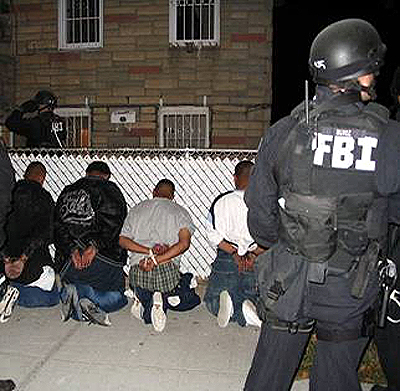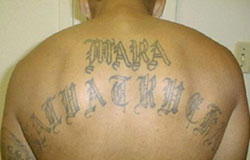Violence: The Tranfer to the United States
The gang culture that has migrated from El Salvador has been directly affected by the violent civil war, from 1980-1992. This background of military training and fear contributes to an even more violent sub-culture of Salvadoran gangs.

Understanding the Basis of Gang Culture
There are different characteristics that must be addressed in order to understand the sub-culture of an ethnic gang. A specific criteria is often used to determine membership: age, race, ethnicity, gender composition, and setting, such as the streets or prison. Also included is the type of activity, purpose of the gang activity, degree of criminality, level of organization, and the function of the group.1 To gang members, another gang member’s neighborhood of origin is the most important thing when relating to each other. However, the most common types of gangs are called spontaneous groups. These are youths who come together for periods of weeks, months, or even a year, but then disintegrate.2
These small cliques often provide the foundations of larger gangs in society. They can deviate into variations, such as specialty cliques. These are groups that arise in the pursuit of illegal activities such as robberies. These gangs do not become very popular in the media because of their small size and short time span. However, the gangs that are usually prominent, such as MS-13, are the most traditionally widespread because they represent area gangs. The MS-13 represents a common territory in which members are the same age, mostly male, and usually of the same geographic origins.3

Member Aspects
The participants of these gangs are defiant individuals, forced into an area where the fight for scarce resources exacerbates the violence and social conflict of the region. These low income communities create a person who is a defiant character, following seven attributes: competitiveness mistrust, self-reliance, social isolation, survival instinct, social Darwinist worldview, and a defiant air. These personality traits can be found amongst many members of low income communities; yet they are most prevalent in gang members. These characteristics are not part of gang membership, but a response to living in low income communities. After these gangs are created, the only way for them to continue to exist is by coping with defiant individuals, and violence is a common tool. 4
After looking at the specific elements of gangs, a new issue emerges. Why do these gangs emerge in places such as the United States? There are several key issues, which include the political unrest that these members face in their home countries, such as the civil war in El Salvador, and their current state of poverty. Gangs are prevalent in low income communities. These low income communities have been victim to the post industrialized era of the 1990s. The economy has changed as a result of several forces which include technology, globalization, movement of capital, and the shift of the economy from manufacturing to information services.5 Hence, those most negatively affected by industrial progress in technology are the unskilled workers that come from third world countries. Also, American companies have begun to hire foreign workers at a lower cost overseas to increase profits. 6
The combination of these factors has not only widened the gap between the rich and the poor, but increased the amount of poor communities, thus exacerbating the gang problem.
Consequences of the civil war
The political unrest in Latin American countries has been another factor in gang proliferation. One of the most important examples is the mass migration from El Salvador to Los Angeles as a result of the civil war. Between the early 1930s and 40s, the Pico Union area in downtown Los Angeles was predominantly inhabited by Anglo-Americans. The area included an upscale life style with retail businesses, apartment buildings, and single family homes.7 Although these buildings exist today, the area has changed dramatically. Now, over half of the population in this area is from El Salvador.8 The MS-13 grew from this change in demography. This can also explain this dramatic change in the ethnic population and in the social situation in the city. The combination of the Salvadorans migrating from a place plagued with violence, combined with low labor skills, and little wealth provided a breeding ground for gang culture in Los Angeles, especially highlighted by the MS-13.
The MS-13, also known as Mara Salvatrucha, was formed by immigrant Salvadoran youths who, upon their arrival in Los Angeles, were soon victimized by local Latino gangs in the area. In response, they fell into the cyclical pattern of coping with violence byforming another gang, whose name is combination of other gang's names: La Mara,” a violent street gang in El Salvador and "Salvatruchas," a term used to denote members of the FMLN. The MS-13 quickly became known as one of the most violent gangs in the area because many of their founding members had experience or training in guerilla warfare, thus gaining a level of sophistication that superseded their rivals.9
The rise of the MS-13 represents the gang themes that have evolved from economic hardship and histories of violence in El Salvador. Furthermore, they also represent the gang culture theme of “defiant character:” the instinct to take over areas where resources are scarce, survival instincts such as guerilla tactics earned in El Salvador, and self- reliance.